You are using an out of date browser. It may not display this or other websites correctly.
You should upgrade or use an alternative browser.
You should upgrade or use an alternative browser.
PVC Tower Cooling Solution
- Thread starter bradsul
- Start date

Help Support Homebrew Talk:
This site may earn a commission from merchant affiliate
links, including eBay, Amazon, and others.
HOPJONES79
Member
I built my kegerator yesterday and used the copper pipe. The space between my mini fridge and the top of the counter top is about 4 inches which I used a piece of galvanized pipe. So far it is a success. No foamy beer pretty consistant temp. Thanks for the post. I used a small piece of electrical tape to hold the pipe in place.
Briz34
Active Member
- Joined
- Jul 25, 2013
- Messages
- 37
- Reaction score
- 1
Guys,
Figured I'd post my pics of this project I just did. I built this kegerator a couple years ago and figured I'd add this modification instead of the fan route. (I also removed my temp sensor which was connected directly to the back coolant plate and left it hanging on the bottom, much better control of temps which will get your beer cooler without a wide range like hey its 40 then a small nudge of the knob and now its 25! haha)
Here's what I picked up: 4' of 1/2" copper pipe (type L cause it was cheaper), 2 - 1/2" pipe T's, 2 - 1/2" elbows, and spray foam.
Luckily I was able to have the guy at the shop cut the pipe for me so I just bought a reamer to remove the burrs. My pipe lengths were 2 - 14" pieces, and 4 - 5.5" pieces.
I had to remove the top connections due to the keg connectors to tube connection having some kind of crimped clamp instead of a pipe clamp (not a big deal just more work). Added plastic wrap on the ends of the beers lines and just slid them up the copper pipe (remember to add the 1/2" T connection on the bottom!) and installed the beer line back onto the metal tube fitting then back onto the tap shank. Notice there's rubber bands in-between the pipe and the tubes, this is to hold them in place while I sprayed the foam and it set. I also manipulated the beer lines so that the pipes stayed away from the edges and didn't move during the set-up time. Then I started from the bottom and sprayed foam until the bottom was filled and then filled the top. Here's where you should be cautious; DO NOT COMPLETELY FILL THE TOWER WITH FOAM! What I mean by this is leave a good 1-2" of the copper exposed to allow for the foam to expand and NOT GO PAST the copper pipe. You want the tops exposed to keep that small pocket of air cooled as well. Yes you can trim back the foam however it's just an extra pain especially when it gets around your tube clamp (want to make sure you have access to those if you ever have to remove the line in the future).
I currently have my too kegs (dark cherry lager and canadian blonde XXX X= increased alcohol content) chillin there then will start carbonating soon. I should have some results in 2 weeks.

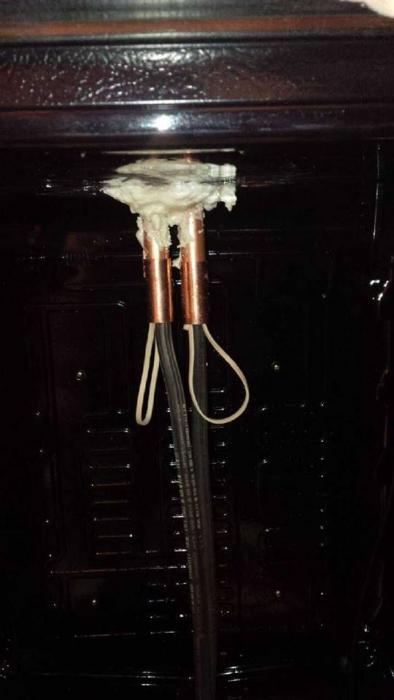
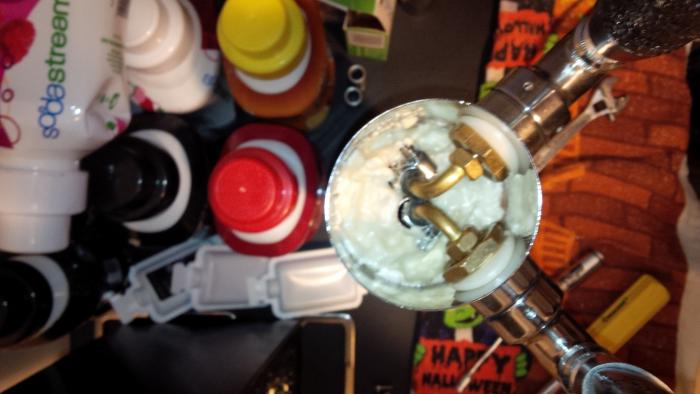
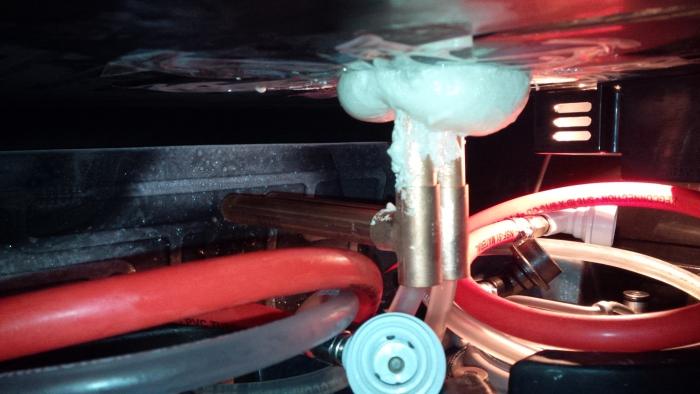
Figured I'd post my pics of this project I just did. I built this kegerator a couple years ago and figured I'd add this modification instead of the fan route. (I also removed my temp sensor which was connected directly to the back coolant plate and left it hanging on the bottom, much better control of temps which will get your beer cooler without a wide range like hey its 40 then a small nudge of the knob and now its 25! haha)
Here's what I picked up: 4' of 1/2" copper pipe (type L cause it was cheaper), 2 - 1/2" pipe T's, 2 - 1/2" elbows, and spray foam.
Luckily I was able to have the guy at the shop cut the pipe for me so I just bought a reamer to remove the burrs. My pipe lengths were 2 - 14" pieces, and 4 - 5.5" pieces.
I had to remove the top connections due to the keg connectors to tube connection having some kind of crimped clamp instead of a pipe clamp (not a big deal just more work). Added plastic wrap on the ends of the beers lines and just slid them up the copper pipe (remember to add the 1/2" T connection on the bottom!) and installed the beer line back onto the metal tube fitting then back onto the tap shank. Notice there's rubber bands in-between the pipe and the tubes, this is to hold them in place while I sprayed the foam and it set. I also manipulated the beer lines so that the pipes stayed away from the edges and didn't move during the set-up time. Then I started from the bottom and sprayed foam until the bottom was filled and then filled the top. Here's where you should be cautious; DO NOT COMPLETELY FILL THE TOWER WITH FOAM! What I mean by this is leave a good 1-2" of the copper exposed to allow for the foam to expand and NOT GO PAST the copper pipe. You want the tops exposed to keep that small pocket of air cooled as well. Yes you can trim back the foam however it's just an extra pain especially when it gets around your tube clamp (want to make sure you have access to those if you ever have to remove the line in the future).
I currently have my too kegs (dark cherry lager and canadian blonde XXX X= increased alcohol content) chillin there then will start carbonating soon. I should have some results in 2 weeks.




H2B
Member
Yes that is true. Space considerations and clearance don't allow that in my case. But there is also less than 1C differential between the temperature of the copper in my fridge and at the top of the tower so I'm not worried about it in my case.
Can someone see if they can tell where I went wrong? I'm on my third attempt at a copper pipe setup on my new kegerator... and am running out of money and patients on getting a perfect pour every time.
I have two pieces of 1/2" copper pipe running up as close as possible to the shank, and as far into the kegerator as possible. I have wrapped each pipe in PVC pipe insulation tape, wrapped that in the best foam insulation I could find, then wrapped that again in the PVC pipe insulation tape. I left a lot of extra foam at the top, to fill the entire void between my shanks and the cap on the tower, and have the insulation going down to right where the pipes enter the kegerator. The pipes extend down 5-6" then I have a T connection where a ridiculous amount of copper extends back to the cooling plate and then across it to the fan. I couldn't fit more copper, or more insulation. There is no exposed copper anywhere outside of the fridge.
Brad, how are you only seeing 1C (I assume that's one degree?) difference from the inside of the kegerator and the top of the tower. I'm reading 34 degrees inside, and 58 degrees at the top... I saw it drop to about 48 up top, when I turned on "Deep Chill" (just the fan staying on and trying to cool to 32) and ran it all night, but my salesman said it can freeze my keg.
I JUST learned as much as I was able to comprehend on "balancing my system" and I have 40" of 3/16" ID vinyl beer line, at 8psi, with and Stone IPA (2.3 CO2 volume?)... STILL getting a gnarly first pour. I cannot figure out what I'm doing wrong.
Anyone seeing a flaw in my system? If so, please dumb down your answer as much as possible I'm just an alcoholic, and not a pro, on this most nobel quest.
Thanks


- Joined
- Mar 2, 2011
- Messages
- 414
- Reaction score
- 57
Looks like more than enough copper to me.
When I had one of these fridges, I filled my entire tower (except the top few inches) with expanding foam, this provided the insulation needed and glued the copper in place. I used some flexible foam sheets to fill the void at the top so I could access and change the lines if needed.
Also 40" lines are not long enough, I use 10 feet of 3/16" lines.
When I had one of these fridges, I filled my entire tower (except the top few inches) with expanding foam, this provided the insulation needed and glued the copper in place. I used some flexible foam sheets to fill the void at the top so I could access and change the lines if needed.
Also 40" lines are not long enough, I use 10 feet of 3/16" lines.

$22.00 ($623.23 / Ounce)
AMZLMPKNTW Ball Lock Sample Faucet 30cm Reinforced Silicone Hose Secondary Fermentation Homebrew Kegging joyful
无为中南商贸有限公司

$53.24
1pc Hose Barb/MFL 1.5" Tri Clamp to Ball Lock Post Liquid Gas Homebrew Kegging Fermentation Parts Brewer Hardware SUS304(Liquid Hose Barb)
Guangshui Weilu You Trading Co., Ltd

$44.99
$49.95
Craft A Brew - Mead Making Kit – Reusable Make Your Own Mead Kit – Yields 1 Gallon of Mead
Craft a Brew

$719.00
$799.00
EdgeStar KC2000TWIN Full Size Dual Tap Kegerator & Draft Beer Dispenser - Black
Amazon.com

$7.79 ($7.79 / Count)
Craft A Brew - LalBrew Voss™ - Kveik Ale Yeast - For Craft Lagers - Ingredients for Home Brewing - Beer Making Supplies - (1 Pack)
Craft a Brew

$28.98
Five Star - 6022b_ - Star San - 32 Ounce - High Foaming Sanitizer
Great Fermentations of Indiana

$53.24
1pc Hose Barb/MFL 1.5" Tri Clamp to Ball Lock Post Liquid Gas Homebrew Kegging Fermentation Parts Brewer Hardware SUS304(Liquid Hose Barb)
yunchengshiyanhuqucuichendianzishangwuyouxiangongsi

$58.16
HUIZHUGS Brewing Equipment Keg Ball Lock Faucet 30cm Reinforced Silicone Hose Secondary Fermentation Homebrew Kegging Brewing Equipment
xiangshuizhenzhanglingfengshop

$479.00
$559.00
EdgeStar KC1000SS Craft Brew Kegerator for 1/6 Barrel and Cornelius Kegs
Amazon.com

$76.92 ($2,179.04 / Ounce)
Brewing accessories 1.5" Tri Clamp to Ball Lock Post Liquid Gas Homebrew Kegging Fermentation Parts Brewer Hardware SUS304 Brewing accessories(Gas Hose Barb)
chuhanhandianzishangwu

$20.94
$29.99
The Brew Your Own Big Book of Clone Recipes: Featuring 300 Homebrew Recipes from Your Favorite Breweries
Amazon.com

$10.99 ($31.16 / Ounce)
Hornindal Kveik Yeast for Homebrewing - Mead, Cider, Wine, Beer - 10g Packet - Saccharomyces Cerevisiae - Sold by Shadowhive.com
Shadowhive

$176.97
1pc Commercial Keg Manifold 2" Tri Clamp,Ball Lock Tapping Head,Pressure Gauge/Adjustable PRV for Kegging,Fermentation Control
hanhanbaihuoxiaoshoudian

$159.50 ($26.58 / Count)
3M High Flow Series System BREW120-MS, 5616001, For Brewed Coffee and Hot Tea, Valve-in-Head Design
Amazon.com

$33.99 ($17.00 / Count)
$41.99 ($21.00 / Count)
2 Pack 1 Gallon Large Fermentation Jars with 3 Airlocks and 2 SCREW Lids(100% Airtight Heavy Duty Lid w Silicone) - Wide Mouth Glass Jars w Scale Mark - Pickle Jars for Sauerkraut, Sourdough Starter
Qianfenie Direct
bajaedition
Well-Known Member
- Joined
- Dec 30, 2013
- Messages
- 1,187
- Reaction score
- 307
I only insulate a thin sheet around the inside of the tower and use a small fan to blow cool air up into the tower
I have no issues at all
I have no issues at all
bajaedition
Well-Known Member
- Joined
- Dec 30, 2013
- Messages
- 1,187
- Reaction score
- 307
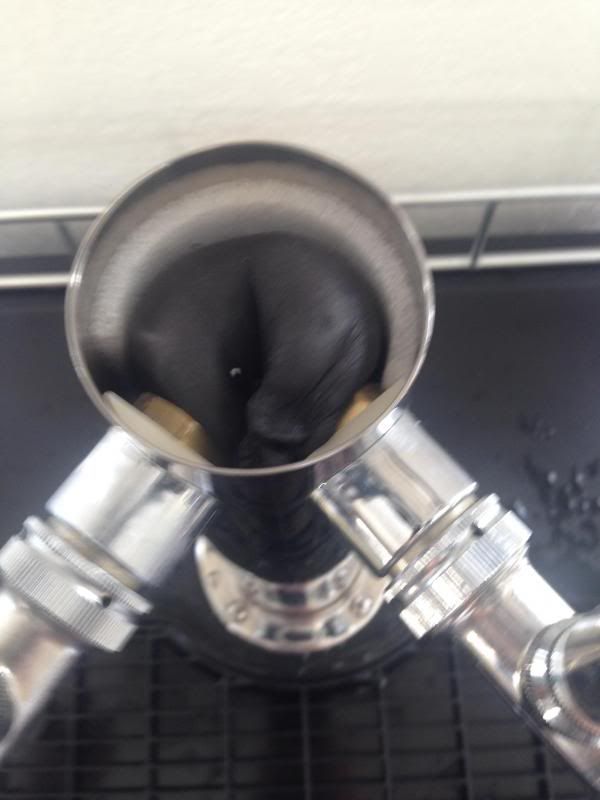
problem I see is that you have insulated the entire top from getting cooling from the bottom
look at it like this, the void in the top is being affected by the mass of the metal around it, all of that metal is being heated by the outside ambient temperature and the only thing cooling down is the copper line and the beer coming up from the bottom. you are using only convection as there is no air flow in there. so as the amount of mass in contact of the warm air is significantly higher than the amount of mass in contact with the cool air below the warm air wins out. take this with the fact that warm air rises and cold air lowers you can see why the top is not cooling, Now if you were to remove the insulation from around the pipes coming from below, and insulate around the inside of the tower leaving enough room for air to flow, then find a way to recirculate the air in the tower you will be introducing more cool air around the beer lines and cooling them off, once you hit the faucets there is not much you can do as the mass of metal is going to over come efforts from below, unless you have a near constant flow rate of cool beer those faucets will remain warm
Towers with a top box are designed to have the max amount of air flow around the beer lines to keep the beer cool, simple tube towers do not have that luxury so you need to move the air faster to keep more cooling air around the lines.
HomeBrewFoSho
Well-Known Member
Yeah. Can't speak on the cooling since I have a remote glycol setup but even when I had my keezer I never ran less than 10' of line and always had a perfect pour
Sent from my iPhone using Home Brew
Sent from my iPhone using Home Brew
lukebeulah
Well-Known Member
The issue is the line length. You should be running at about 12psi on your CO2 to keep your beer carbed properly. To do this you need to be running lines at around 10 feet. Once you do it, you will know why people always have this response to "foamy beer that is not overcarbed"
Sent from my iPad using Home Brew
Sent from my iPad using Home Brew
wilserbrewer
BIAB Expert Tailor
Perhaps I'm mistaken, but I thought that with the copper tubing to cool the tower, both ends of the tubing are to be left open with enough gap to provide airflow into the tower.
I thought that the copper not only cools the tower, but also causes the cold air to drop out of the copper tube thusly creating passive air circulation to the tower.
Sent from my iPhone using Home Brew
I thought that the copper not only cools the tower, but also causes the cold air to drop out of the copper tube thusly creating passive air circulation to the tower.
Sent from my iPhone using Home Brew
H2B
Member
Thank you guys for the feedback... all you guys seem to be on the side of the fence I want to get to (the low foam/greener side), so please don't take the following as any sort of argument or disrespect, because I appreciate any knowledge being shared with me... I just want to understand... and also I'm sorry for the length of this post...
I'm definitely going to get myself some more beer line, which previously I was against, because I think MAYBE I now understand. Please tell me if my thought process makes sense....
... In attempting to "balance" my system, since I read this is basically the first thing I should do to ever expect good beer, all tables and charts mentioning length, let's use this one for example:
https://www.homebrewtalk.com/f84/beer-line-length-pressure-calculator-35369/
urge me to go shorter as the temperature drops. I've been using the temperature inside my kegerator, which was incorrect, as I should have been using the one inside my beer tower? though this table does not go to the 58 degrees i am now at in my tower, I can see that if the pattern continues, 60 to 70 degrees would indeed require about 10' of line. So is this the reason 10' is suggested, because it's balancing the system for us "hot tower" guys?
If that logic was sound, then would the system then not be out of balance, after the first half pint because then the beer would be at the 33 degrees of the kegerator. Again, I still don't understand the tables that well to know the impact, but it would seem to me that the beer would now be over carbonated at this point? I'm making this assumption off Beer absorbing CO2 better when it's cold, and now the pressure is higher to get the beer through all that line.
Either way I still am going to get the longer beer line, but IF I am able to wrap my head around what's going on, this baby might one day be able to feed himself....
That being said, I still want to cool my tower. I understand the idea of all the warm contact winning over the cold, however that was my reasoning for the insulation and the filling of the void at the top. If there was no room for warm air, and no contact with warm surfaces, other than the faucet (which I would hope wouldn't have too big an impact, because I can't change that variable), the copper would conduct the cold up, and the insulation would protect it from any warmth.... with the only limiting factor on the cooling being copper's physical ability to conduct temperature.
For now I want to avoid a fan because honestly getting that wired, built, etc is just entering a whole new area of ignorance for me, even though I agree with you guys 100% that this is a sure way to achieve the result I desire. I thank you for those tips, and will keep them as a future option.
Brad however was able to get the result I want, by doing what I feel is pretty much the same thing I did, I just don't understand how we got different results (This is assuming his "1C" means one degree). His spray foam filled the tower too preventing any air circulation, and he also filled the top void of the tower.
Thank you guys again, and I can't wait to see how the beer line helps.
I'm definitely going to get myself some more beer line, which previously I was against, because I think MAYBE I now understand. Please tell me if my thought process makes sense....
... In attempting to "balance" my system, since I read this is basically the first thing I should do to ever expect good beer, all tables and charts mentioning length, let's use this one for example:
https://www.homebrewtalk.com/f84/beer-line-length-pressure-calculator-35369/
urge me to go shorter as the temperature drops. I've been using the temperature inside my kegerator, which was incorrect, as I should have been using the one inside my beer tower? though this table does not go to the 58 degrees i am now at in my tower, I can see that if the pattern continues, 60 to 70 degrees would indeed require about 10' of line. So is this the reason 10' is suggested, because it's balancing the system for us "hot tower" guys?
If that logic was sound, then would the system then not be out of balance, after the first half pint because then the beer would be at the 33 degrees of the kegerator. Again, I still don't understand the tables that well to know the impact, but it would seem to me that the beer would now be over carbonated at this point? I'm making this assumption off Beer absorbing CO2 better when it's cold, and now the pressure is higher to get the beer through all that line.
Either way I still am going to get the longer beer line, but IF I am able to wrap my head around what's going on, this baby might one day be able to feed himself....
That being said, I still want to cool my tower. I understand the idea of all the warm contact winning over the cold, however that was my reasoning for the insulation and the filling of the void at the top. If there was no room for warm air, and no contact with warm surfaces, other than the faucet (which I would hope wouldn't have too big an impact, because I can't change that variable), the copper would conduct the cold up, and the insulation would protect it from any warmth.... with the only limiting factor on the cooling being copper's physical ability to conduct temperature.
For now I want to avoid a fan because honestly getting that wired, built, etc is just entering a whole new area of ignorance for me, even though I agree with you guys 100% that this is a sure way to achieve the result I desire. I thank you for those tips, and will keep them as a future option.
Brad however was able to get the result I want, by doing what I feel is pretty much the same thing I did, I just don't understand how we got different results (This is assuming his "1C" means one degree). His spray foam filled the tower too preventing any air circulation, and he also filled the top void of the tower.
Thank you guys again, and I can't wait to see how the beer line helps.
H2B
Member
The issue is the line length. You should be running at about 12psi on your CO2 to keep your beer carbed properly. To do this you need to be running lines at around 10 feet. Once you do it, you will know why people always have this response to "foamy beer that is not overcarbed"
Sent from my iPad using Home Brew
Luke, Purplehaze & Homebrewforsure... Thank you guys!!!
I thrilled to say that I'm a survivor. I've been battling foam for 5 long years, and after a risky kegerator transplant, a double perlick tap bypass and twin copper stints, you three gave me the gift of a perfect pour!
Even though so much is known about this terrible condition, and it affects so many of us, so many foamy beers still find their way to under privileged home bars across the world, which is why I pledge my efforts to share my new found understanding of this disease with all who will listen.
Please don't think of me as a hero, I'm just an ordinary man... however my yellow "Pour Strong" bracelets and posters of my perfect pours are available for sale in the lobby.... and there may or may not be a character based on me in the upcoming Incredibles 2.
I owe all of my pour-glory, "poury" if you will, to this forum and fellow drinkers like yourselves... Thank you! and Cheers!
hockeyandbeer
Member
- Joined
- Apr 9, 2014
- Messages
- 6
- Reaction score
- 0
Thanks for all the help on here. First time user on here. I want to use the copper pipe idea as well. I was originally going to drill a 2" hole for my tower, but should be able to make it just large enough for the one copper pipe for a single line correct? Which is better for me as it's a thick piece of metal to drill through. Or would a larger hole help to get more cold air up there? I saw an earlier post where the guy used spray foam to seal off any gaps. Thanks!
Sent from my iPad using Home Brew
Sent from my iPad using Home Brew
stever1000
Well-Known Member
- Joined
- Oct 15, 2014
- Messages
- 822
- Reaction score
- 49
Lots of good info, going to try this soon!
I love this idea, and I am in the process of installing right now, but I have a question.
Is there an easy way to change the beer lines with this setup? It seems like you would have to remove the tower, faucets, hose clamps, copper pipes, etc. For me, installing the lines took quite a bit of time (mostly spent wrestling with the inserting the beer lines into the shanks and clamping).
Has anyone had to change their lines with this setup yet? If so, any insight would be helpful.
Is there an easy way to change the beer lines with this setup? It seems like you would have to remove the tower, faucets, hose clamps, copper pipes, etc. For me, installing the lines took quite a bit of time (mostly spent wrestling with the inserting the beer lines into the shanks and clamping).
Has anyone had to change their lines with this setup yet? If so, any insight would be helpful.
Hi - sorry if this seems unrelated, but I am doing a wine cooler conversion and have added copper pipes for cooling the lines and it seems to be working well on a test run (kegerator filled with cases of water). My copper into the tower runs up to about 1/2" below the shank, since I was trying to leave room for the stepdown clamp. However, in reading through this post, I see several people that are not using clamps (see posts 136 and 139 as examples). So do you need the clamps, or not? If not, I can extend my copper about 3/4 inch to be up over the shank, which some posters have said is preferable. I'm hoping to solder pipes today!  Thanks!
Thanks!
Edit: the attached picture is from post 139 - it's not my setup. I will post pics on a build thread later.

Edit: the attached picture is from post 139 - it's not my setup. I will post pics on a build thread later.

Hi Beermati,
I think you may be over-thinking this. The copper is used as a radiator to conduct heat away from the beer lines down into the cold box, where it is dissipated just like any other heat (eg from a room-temp keg). You don't need the copper to go all the way to the end, you don't need to solder anything, and you don't need clamps! As in the photo you re-posted, close is good enough.
Scott (or31acres)
I think you may be over-thinking this. The copper is used as a radiator to conduct heat away from the beer lines down into the cold box, where it is dissipated just like any other heat (eg from a room-temp keg). You don't need the copper to go all the way to the end, you don't need to solder anything, and you don't need clamps! As in the photo you re-posted, close is good enough.
Scott (or31acres)
cyberbackpacker
Well-Known Member
However, in reading through this post, I see several people that are not using clamps
Hi Beermati,
you don't need clamps!
I think you miss understood his question with regards to clamps or31acres... he's asking if he needs clamp on the beer hose that is over the hose barb for the shank.
With that said, beermati, USE clamps on your beer line. The extra little bit of copper is not worth the potential leak and fail point between the hose and hosebarb on the shank by not using clamps.

Well, in a balanced system, the pressure should be near 0 at the faucet. But when it's closed, the pressure goes up, I think I would feel better with a clamp.
Well, in a balanced system, the pressure should be near 0 at the faucet. But when it's closed, the pressure goes up, I think I would feel better with a clamp.
Yeah, I'm with you. I have to heat up my 3/16" ID beer and gas lines to get them onto 1/4" barbed fittings, and once they're cool they're likely never going anywhere, but I still put clamps on all of 'em.
There's enough unforeseen drama in life as it is, I don't need no 'sploding hoses
Cheers!
Thanks for the replies! Yes, Kevin, I was referring to the beer line clamps on the shanks, since several posts earlier in the thread showed photos with no clamps. I went ahead and cut the pipes near the bottom of the shanks and installed with clamps.




wilserbrewer
BIAB Expert Tailor
I recall seeing this done previously with several copper tubes just shoved up in the tower without the beer line inside the copper. I think having copper in the tower and extending down into the colder fridge helps to chill the tower and line, that's all folks.
Since it seems this thread is still kicking a bit, I have a question: any suggestions on how to use copper in a 4-5 faucet tower that "loops" for lack of a better description? Like the black iron pipe that go up, across and down, with the faucets along the cross-pipe. Hope that description makes sense. Trying to plan my keezer build, but can't make up my mind on how i want to go with it.
Jbone, good question! I think you're going to be pretty limited seeing you have limited room to run that many copper lenghts... Maybe your best bet is to insulate the lines with a couple cooper lenghts vs running them inside.
Heres what ive done so far, well see if it works out as I still havent tested it yet.
The pipes are in direct line ofthe evap fan which should keep them cold but I wouldnt be too heart broken if I have to run a couple oz before its "perfect"
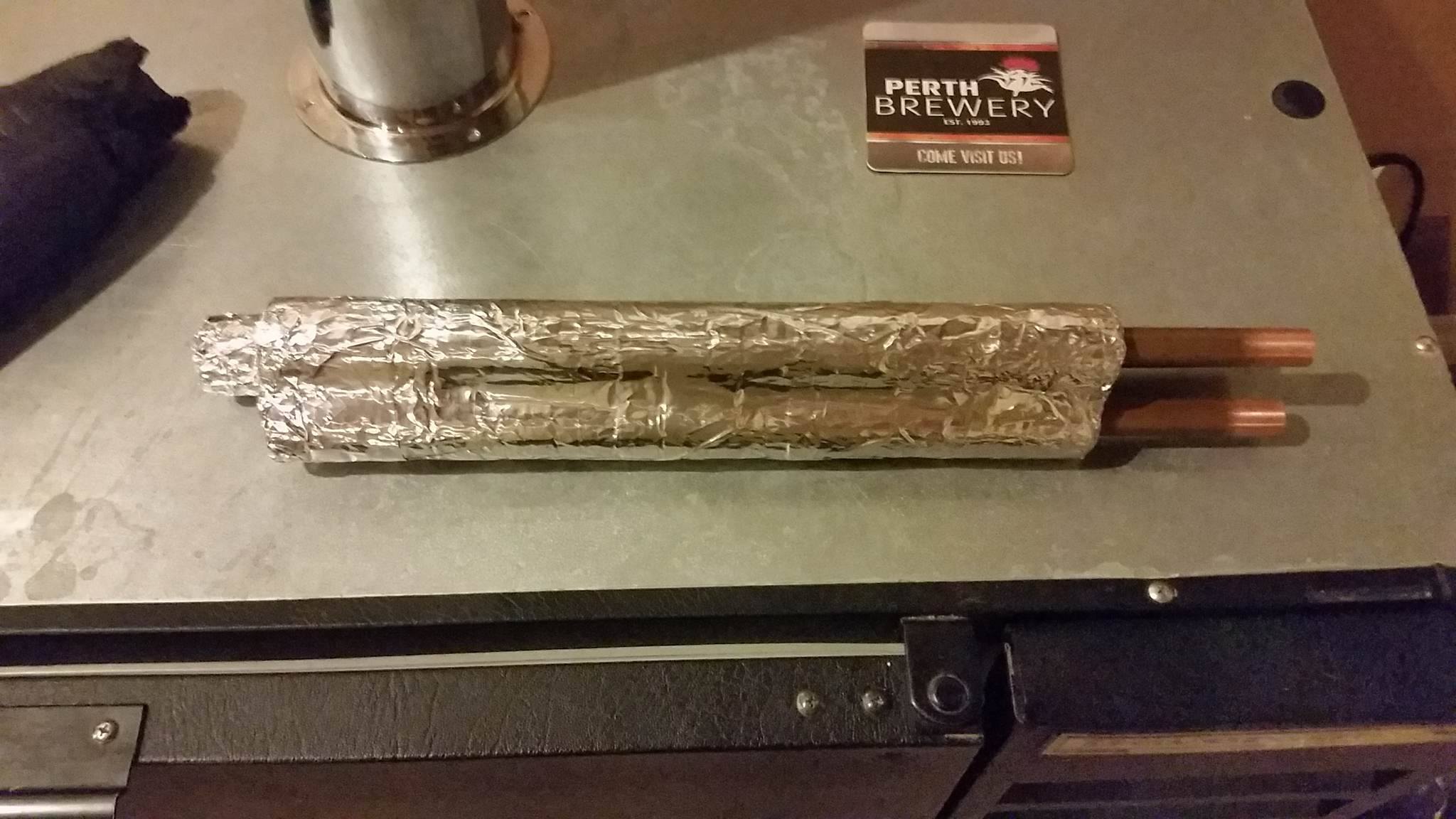
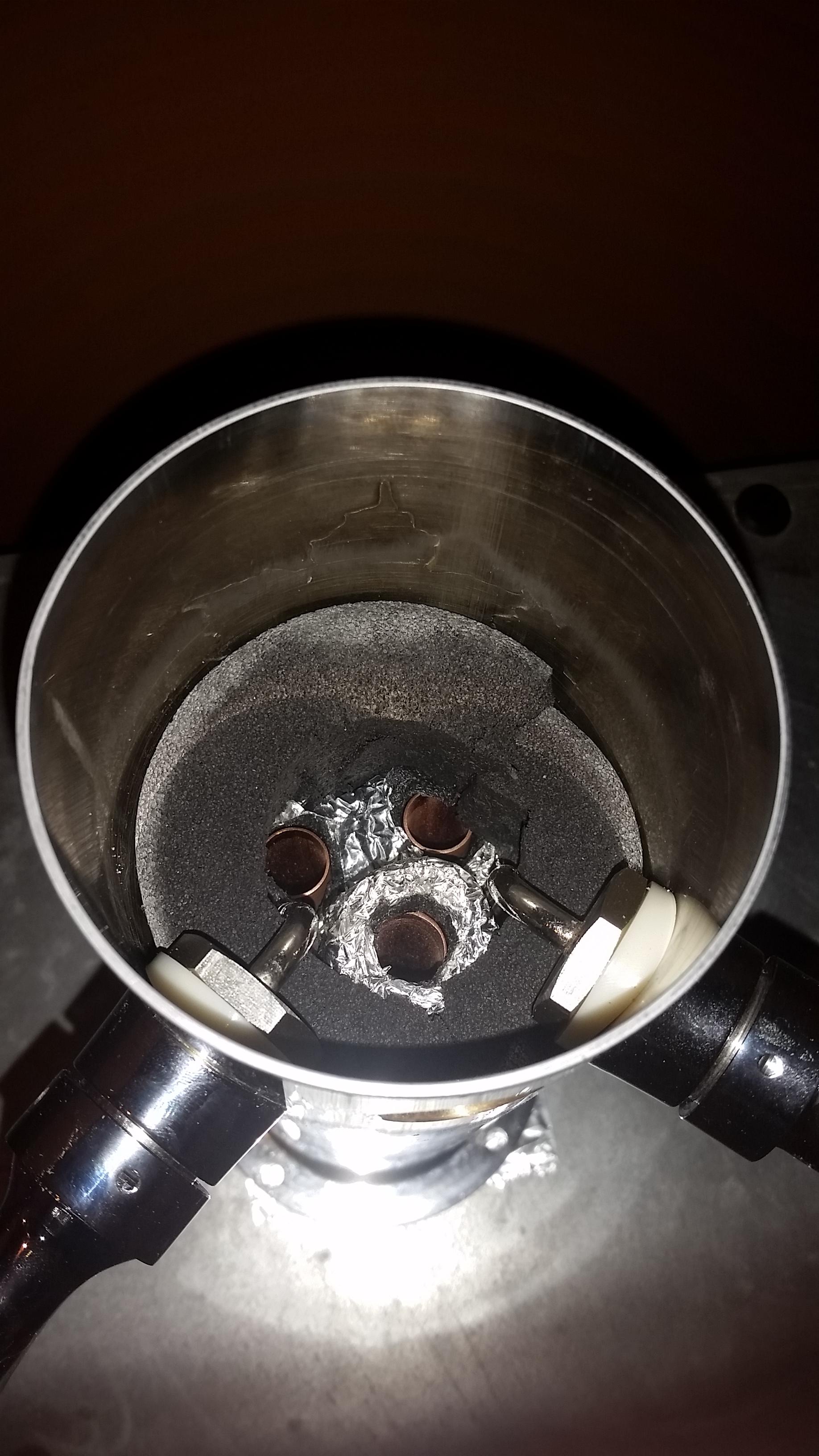
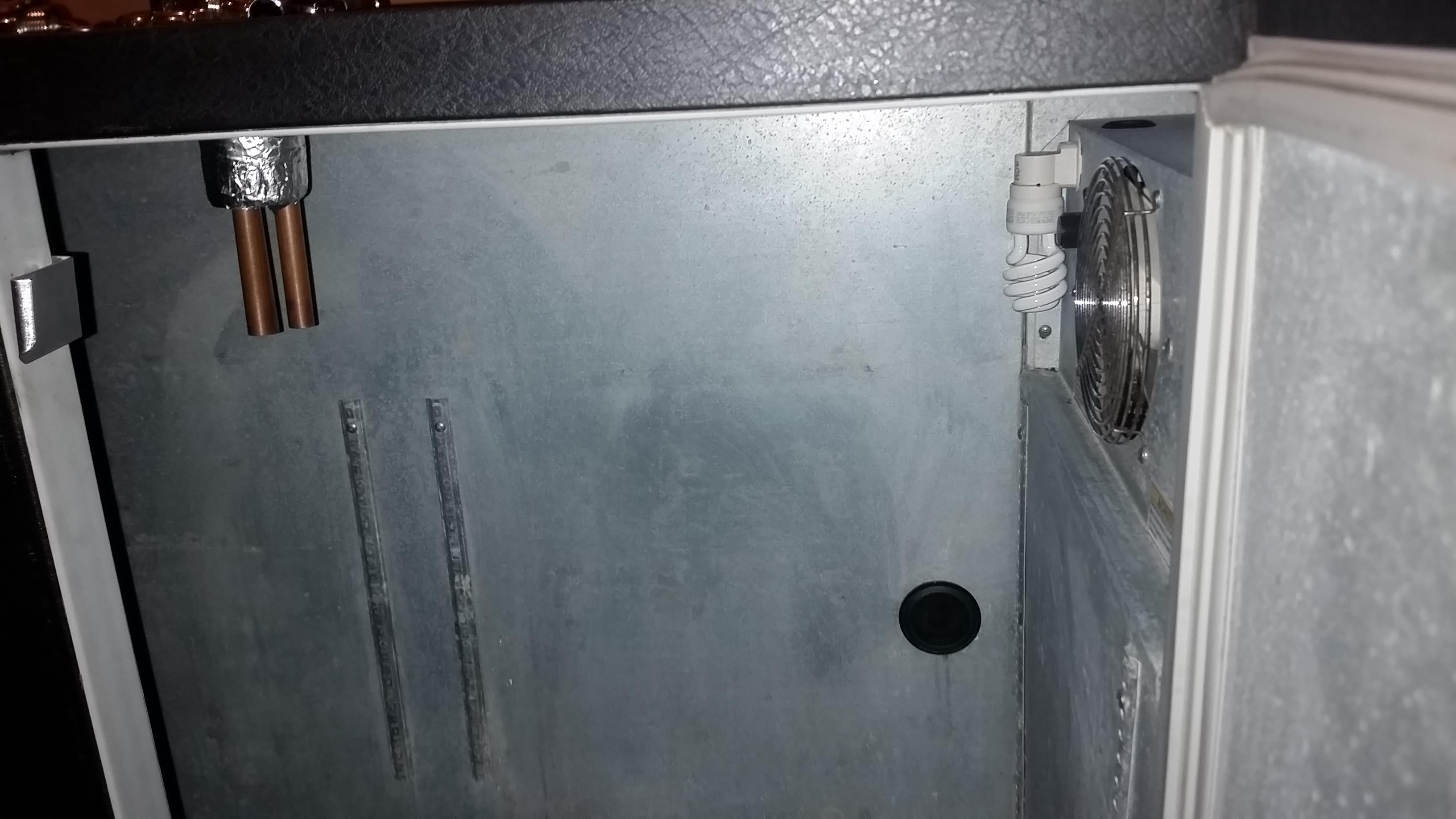
Heres what ive done so far, well see if it works out as I still havent tested it yet.
The pipes are in direct line ofthe evap fan which should keep them cold but I wouldnt be too heart broken if I have to run a couple oz before its "perfect"



ive had my fridge running for about a week now with the tower, no kegs in it yet as im picking those up in 3 days, ive noticed A LOT of condensation forming inside the copper tubes and causing puddles to the point I have a towel below it to catch the water.
And as you can see in the pics, I have no shortage of insulation in the tower so not quite sure what I will do about this issue
And as you can see in the pics, I have no shortage of insulation in the tower so not quite sure what I will do about this issue
Just wanted to report back on the outcome of my passive tower cooling mod, its been working great! I do get a little foam on 1st pour but thats due to the beer sitting in the tap over time. a quick side pour of 1-2 oz's would clear it up if you are picky.
Only down fall I have so far is the condensation build up in the copper pipes, but I just threw a rag underneath to catch the water.
I do however think I am benefiting from the fact that my evap fan is always running providing a constant cold draft on the copper.
stocked up and ready to enjoy!

Only down fall I have so far is the condensation build up in the copper pipes, but I just threw a rag underneath to catch the water.
I do however think I am benefiting from the fact that my evap fan is always running providing a constant cold draft on the copper.
stocked up and ready to enjoy!

johnbrown86
Member
I will also choose PVC pipe for this. PVC has thermal insulation characteristics. When PVC is mixed with Polyurea, it gives thermal insulation benefits. So you can choose PVC pipes instead of copper pipe. PVC panels are also waterproof building material and the price is less than copper pipe.
I think that may be missing the purported point of using copper "sleeves" for the beer lines: high thermal conductivity to pull "heat" out of the lines.
And in any case the last thing you want to do is insulate beer lines from the cold cabinet air...
Cheers!
And in any case the last thing you want to do is insulate beer lines from the cold cabinet air...
Cheers!
Similar threads
- Replies
- 7
- Views
- 678
- Replies
- 3
- Views
- 893



![Craft A Brew - Safale BE-256 Yeast - Fermentis - Belgian Ale Dry Yeast - For Belgian & Strong Ales - Ingredients for Home Brewing - Beer Making Supplies - [3 Pack]](https://m.media-amazon.com/images/I/51bcKEwQmWL._SL500_.jpg)






































